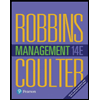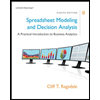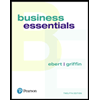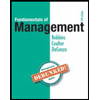
Concept explainers
To determine:
The level of agreement with the statement "When shopping at the supermarket, it is appropriate to switch price tags on packages".
Introduction:
Morals are judgments, principles, and convention of good conduct in the society. They guide people toward acceptable behavior with regard to essential values. The main purpose of doing business is making money but a business also has some fiduciary responsibilities. It is true that today there is a huge competition in the business world but a company should not forget its ethical and social responsibilities. A company can still make money while adhering to an ethical code of business operations. A moral company gains advantage of its reputation and faith of the society. Good
Want to see the full answer?
Check out a sample textbook solution
Chapter 3 Solutions
Fundamentals of Management: Essential Concepts and Applications (9th Edition)
- 1. Discuss how the application of PESTEL analysis can assist small businesses in identifying and managing external risks. Provide examples from at least three PESTEL categories. (20 marks)arrow_forward. Mention four early warning indicators that a business may be at risk.arrow_forward5. A risk that has both a high impact and high probability is referred to as A. Negligible B. Moderate C. Low D. Extreme 6. A business continuity plan is mainly used to_ A. Increase profits B. Handle daily tasks C. Prepare for disruptions D. Advertise services 7. What is the role of a risk owner? A. To finance the risk B. To monitor and manage a specific risk C. To create risks D. To avoid planning 8. Early warning indicators help businesses to A. Avoid legal actions B. Grow rapidly C. Detect potential risks D. Hire employees 9. A hazard-based risk includes A. Political instability B. Ergonomic issues C. Market demand D. Taxation changesarrow_forward
- 1. What is the primary purpose of risk management in small businesses? A. To eliminate all risks B. To predict profits C. To reduce and control risks D. To create new risks 2. Which of the following is a type of operational risk? A. Interest rate change B. Natural disaster C. Supplier failure D. Tax policy change 3. SWOT analysis identifies all EXCEPT A. Strengths B. Weaknesses C. Tactics D. Opportunities 4. Which strategy involves taking no action against a risk? A. Mitigation B. Avoidance C. Acceptance D. Transferarrow_forward5. A risk that has both a high impact and high probability is referred to as A. Negligible B. Moderate C. Low D. Extreme 6. A business continuity plan is mainly used to_ A. Increase profits B. Handle daily tasks C. Prepare for disruptions D. Advertise services 7. What is the role of a risk owner? A. To finance the risk B. To monitor and manage a specific risk C. To create risks D. To avoid planning 8. Early warning indicators help businesses to A. Avoid legal actions B. Grow rapidly C. Detect potential risks D. Hire employees 9. A hazard-based risk includes A. Political instability B. Ergonomic issues C. Market demand D. Taxation changesarrow_forward1. What is the primary purpose of risk management in small businesses? A. To eliminate all risks B. To predict profits C. To reduce and control risks D. To create new risks 2. Which of the following is a type of operational risk? A. Interest rate change B. Natural disaster C. Supplier failure D. Tax policy change 3. SWOT analysis identifies all EXCEPT A. Strengths B. Weaknesses C. Tactics D. Opportunities 4. Which strategy involves taking no action against a risk? A. Mitigation B. Avoidance C. Acceptance D. Transferarrow_forward
- List and briefly describe four risk response strategies.arrow_forwardExplain the purpose of a risk register.arrow_forwardAssume that your business is going to apply for a bank loan. Step into the shoes of a banking official who has the power to say yes or no to your loan application. From the bank’s vantage point, what are the strengths and weaknesses of your business plan? Does your plan seem realistic, given the financial assumptions and the business environment? What questions would you, as a bank officer, ask about your business plan? As the entrepreneur behind the business plan, how would you answer these questions and persuade the bank to approve your loan? Write up your questions and answers in one paragraph. Then use what you’ve learned to further strengthen your plan.arrow_forward
- Assume that your business is going to apply for a bank loan. Step into the shoes of a banking official who has the power to say yes or no to your loan application. From the bank’s vantage point, what are the strengths and weaknesses of your business plan? Does your plan seem realistic, given the financial assumptions and the business environment? What questions would you, as a bank officer, ask about your business plan? As the entrepreneur behind the business plan, how would you answer these questions and persuade the bank to approve your loan? Write up your questions and answers in one paragraph. Then use what you’ve learned to further strengthen your plan.arrow_forwardEven before you launch your business, you have to be ready to handle the funds that will flow in and out as you buy raw materials, pay rent, receive customer payments, and reserve cash to pay taxes. Which financial services should you have in place on your first day in business? Which might be needed months later, after you’ve established your business? Write two to three sentences about your company’s need for financial services, now and during the first year.arrow_forwardChester has negotiated a new labor contract for the next round that will affect the cost for their product Camp. Labor costs will go from $3.65 to $4.15 per unit. Assume all period and variable costs as reported on Chester's Income Statement remain the same. If Chester were to pass on half the new labor costs to their customers, how many units of product Camp would need to be sold next round to break even on the product? Select : 1 a) 1,826 b) 1,916 c) 1,743 d) 2,428arrow_forward
 Understanding BusinessManagementISBN:9781259929434Author:William NickelsPublisher:McGraw-Hill Education
Understanding BusinessManagementISBN:9781259929434Author:William NickelsPublisher:McGraw-Hill Education Management (14th Edition)ManagementISBN:9780134527604Author:Stephen P. Robbins, Mary A. CoulterPublisher:PEARSON
Management (14th Edition)ManagementISBN:9780134527604Author:Stephen P. Robbins, Mary A. CoulterPublisher:PEARSON Spreadsheet Modeling & Decision Analysis: A Pract...ManagementISBN:9781305947412Author:Cliff RagsdalePublisher:Cengage Learning
Spreadsheet Modeling & Decision Analysis: A Pract...ManagementISBN:9781305947412Author:Cliff RagsdalePublisher:Cengage Learning Management Information Systems: Managing The Digi...ManagementISBN:9780135191798Author:Kenneth C. Laudon, Jane P. LaudonPublisher:PEARSON
Management Information Systems: Managing The Digi...ManagementISBN:9780135191798Author:Kenneth C. Laudon, Jane P. LaudonPublisher:PEARSON Business Essentials (12th Edition) (What's New in...ManagementISBN:9780134728391Author:Ronald J. Ebert, Ricky W. GriffinPublisher:PEARSON
Business Essentials (12th Edition) (What's New in...ManagementISBN:9780134728391Author:Ronald J. Ebert, Ricky W. GriffinPublisher:PEARSON Fundamentals of Management (10th Edition)ManagementISBN:9780134237473Author:Stephen P. Robbins, Mary A. Coulter, David A. De CenzoPublisher:PEARSON
Fundamentals of Management (10th Edition)ManagementISBN:9780134237473Author:Stephen P. Robbins, Mary A. Coulter, David A. De CenzoPublisher:PEARSON





